
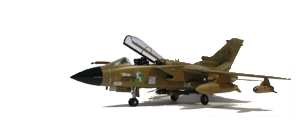


Below is a list of Tips and Tricks we use while modeling. If you're after the online scale converter, click here
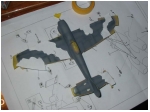 Using paper are often a good idea for complex or small camouflage patterns because the paper is easy to cut into the correct shape.
Using paper are often a good idea for complex or small camouflage patterns because the paper is easy to cut into the correct shape.
 While building Academy's 1/72nd scale Hawker Tempest I thought it would be a good time to perhaps put something up on how I do my preshading. The basic idea of pre shading is to highlight the panel lines in a dark colour before the standard colour is applied. Then the main color is slowly 'layered' ocer the dark lines until the darker lines are only just showing through.
While building Academy's 1/72nd scale Hawker Tempest I thought it would be a good time to perhaps put something up on how I do my preshading. The basic idea of pre shading is to highlight the panel lines in a dark colour before the standard colour is applied. Then the main color is slowly 'layered' ocer the dark lines until the darker lines are only just showing through.
 Ok here's one that I came up with while trying to find a decent way to create a stand with stuff that's just lying around.
The idea is very simple, use the CD as a flat base and cut out a plastic stand from the CD case and mount it into the base.
Ok here's one that I came up with while trying to find a decent way to create a stand with stuff that's just lying around.
The idea is very simple, use the CD as a flat base and cut out a plastic stand from the CD case and mount it into the base.
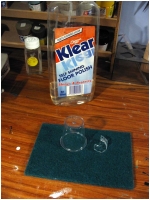 I've only really used this technique on canopies but there's no reason why you couldn't use it on any clear part.
When you get your new kit, the chances are that the canopy has a number of smudges, scrapes and small scratches all of which contribute towards lowering the authenticity of the glass affect.
First you need to give the canopy a decent clean in soapy water to remove an
I've only really used this technique on canopies but there's no reason why you couldn't use it on any clear part.
When you get your new kit, the chances are that the canopy has a number of smudges, scrapes and small scratches all of which contribute towards lowering the authenticity of the glass affect.
First you need to give the canopy a decent clean in soapy water to remove an
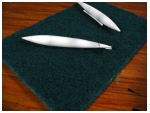 One of the tricky things with spraying smaller parts is figuring out what to do with them after they're sprayed. Toothpicks and similar items are great for gluing onto parts like fuel tanks to act as handles while your spraying but where do you put it after your done?
I've found poly/pot scrubs to be great for this sort of thing. I place the flat scrubbing cloth on the bench and use it
One of the tricky things with spraying smaller parts is figuring out what to do with them after they're sprayed. Toothpicks and similar items are great for gluing onto parts like fuel tanks to act as handles while your spraying but where do you put it after your done?
I've found poly/pot scrubs to be great for this sort of thing. I place the flat scrubbing cloth on the bench and use it
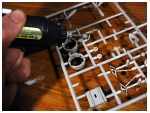 Who hasn't been in the situation where they are removing some impossibly small part from the sprue and it either snaps and gleefully jumps into the waiting maws of the Carpet Monster to be forever lost - or you slip and impale yourself on your newly loaded hobby knife blade.
The answer was really quite simple, but very effective and came from being... well, lazy. I was using my new Drem
Who hasn't been in the situation where they are removing some impossibly small part from the sprue and it either snaps and gleefully jumps into the waiting maws of the Carpet Monster to be forever lost - or you slip and impale yourself on your newly loaded hobby knife blade.
The answer was really quite simple, but very effective and came from being... well, lazy. I was using my new Drem
Check out our new Online Scale conversion tool. Convert from any scale in any unit of measurement to any other scale in any other unit.